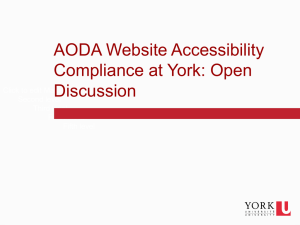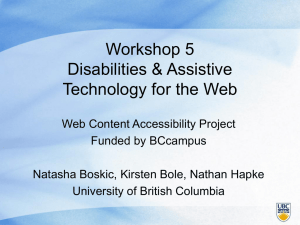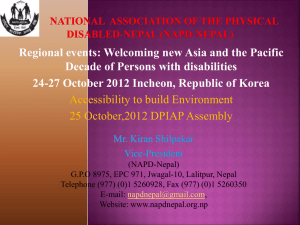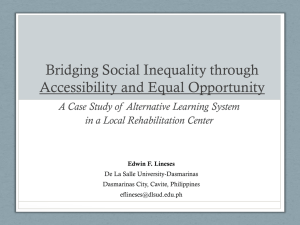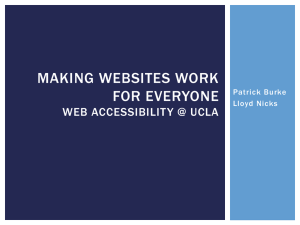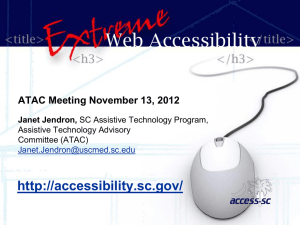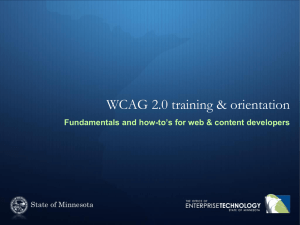presentation is also available in PowerPoint
advertisement
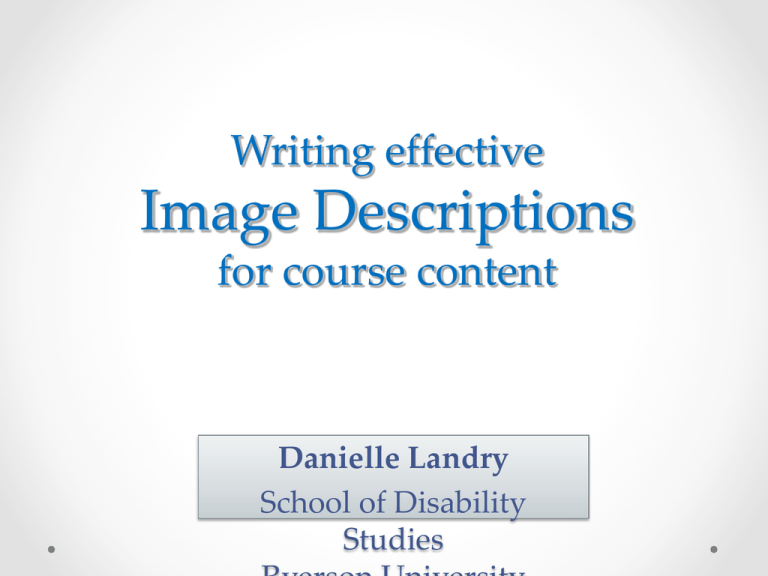
Writing effective Image Descriptions for course content Danielle Landry School of Disability Studies What we’ll cover today… Consider inclusivity and accessibility in the online classroom Learn how to write an effective image description Become aware of a few key considerations: context, length, language Go over a little how-to in Ektron (Ryerson’s Content Management System for online courses) Familiarize ourselves with some useful resources Barriers to education Highest level of educational attainment by disability status for adult Canadians aged 15 to 64 (PALS, 2006) People with Disabilities People w/out Disabilities Below High School Diploma 28% 19% High School Diploma or equivalent 25% 27% Trade Certificate or equivalent 14% 10% College Diploma or equivalent 21% 24% University degree or above 13% 20% Inclusive Classrooms Inclusive classrooms foster a diversity of voices and experiences, enriching discussion and shaping how all students interact with and think about the course material and each other. Changing legislation The Accessibility for Ontarians with Disabilities Act (AODA) is legislation that came into effect in Ontario in 2005. The AODA outlined the procedure for the development of accessibility standards in order to achieve “accessibility for Ontarians with disabilities with respect to goods, services, facilities, accommodation, employment, buildings, structures and premises”. AODA The AODA’s integrated information and communication standard says: •All new websites and web content must conform with WCAG 2.0 Level A by January 1, 2014 (including ‘significant refreshes’ to websites/content) •All websites and web content must conform with WCAG 2.0 Level AA by January 1, 2021. The WCAG 2.0 requires text alternatives be provided for any non-text content (i.e. image descriptions). All online courses will need to comply. AODA It also states: “Every obligated organization that is an educational or training institution shall do the following, if notification of need is given: Provide educational or trainings resources or materials in an accessible format that takes into account the accessibility needs due to a disability of the person with a disability to whom the material is to be provided…” Accessibility features for visually impaired students Providing accessible content for visually impaired students is especially necessary because it’s been overly neglected, even in relation to other disabilities: “Although overall the findings suggest that .… the needs of students in all groups are relatively well met, those of students who are totally blind, those with multiple disabilities, and those with low vision were met least well…” Fichten, C.S., Asuncion, J.V., Nguyen, M.N., Budd, J. & Amsel, R. (2010). Why images matter “It is believed that up to 80% of what children without visual impairments learn is through visual clues” Project IDEAL (2011) Removing images is not the way to remove barriers to accessibility; taking away visual content weakens the learning experience of other students. So what exactly is an Image Description? Descriptions vs. Captions A caption is a heading, a footer or a title that provides an explanation for an image. Descriptions vs. Captions An image description provides a text alternative to an image. It describes images as though it can’t be seen. So what exactly is an Image Description? Image descriptions aren’t complicated, but sitting down to write one makes you realize there is a little more to writing them than you think… Here’s an example. How would you describe the following image? Describe this image How about this image? Do all images need descriptions? A study was conducted in London, England (Petrie, Harrison and Dev, 2005) to find out how visually impaired web users thought images online should be described. Semi-structured interviews were conducted with legally blind participants using JAWS screen readers. A majority of the participants agreed that not all images should be described. Images that DO need descriptions: • Artistic or instructive images • Diagrams and charts • Buttons (i.e. Search buttons) Because how can you know where it’s going to take you, until you click on it? • Products for sale (i.e. textbook covers) Images that DON’T need descriptions: • Uninformative or decorative images (added only for aesthetic value, not content) • Bullets or Spacers (filler images) • Logos (relevant information should be elsewhere) • Images that are already described in text When there is no description needed… A null or empty string ALT text (ALT = “ ”) should be used for images with no informational value. This ensures that screen readers skip over the image Writing an image description Writing an image description What is the image’s purpose? What is it telling us? Why is it there? What is else being said on this page and what unique information is this image providing? Consider the Context The most useful information is usually context dependent. On a retail website, would the description “Women’s jeans” be enough to make you want to buy them? How much information might a shopper looking to purchase a pair of jeans need? Useful information might include the colour, style and cut of the jeans. Consider the context A word on Language Use simple, plain language. The order of the words matters. Put the most important information at the beginning of the description. Guidelines While context matters, some elements in an image generally require describing, including: •Objects, buildings, people •What’s happening/the action •Purpose of the image •Colours in the image •Location •Emotions, atmosphere Describing the subjective Everything is relative. Describing images makes you aware of your own subjectivity. Try to stick to known facts. What can you say that couldn’t (easily) be disputed? Describing the subjective How long is too long? General rule of thumb: try for a balance between quality and quantity. In HTML, you can always use LONGDESC (and ALT-text) to provide a longer description, should people choose to find out more about the image. In Ektron, we need to learn to balance both in one description. Somewhere between a few words and less than 150 characters. An example in length A) B) C) D) E) Skull. Photograph of a skull. Photograph of a human skull. Photograph of a trepanated human skull. Photograph of a trepanated human skull. There is a hole near the top of the skull. F) Photograph of a trepanated human skull. There is a hole near the top of the skull. #3 is placed in front of the skull. G) Photograph of a trepanated human skull. There is a hole near the top of the skull on the right side. #3 is placed front of the skull. H) Photograph of a trepanated human skull on a table. There is a hole near the top of the skull on the right side. #3 is placed front of the skull. One tooth is missing. Inserting image descriptions into Ektron After signing into the content management system in Blackboard (Ektron), right click on the image that needs describing. Select “Edit” This will take you into Editing Mode. Right click on the image again and select “Set Image Properties” Write your image description in the box “Image Alt Text”. Click Ok . Then save the changes to your page. In Word or Adode… It’s just as easy. World Wide Web Consortium (W3C). (2011). PDF1: Applying text alternatives to images with the Alt entry in PDF documents. Techniques for WCAG 2.0. http://www.w3.org/WAI/GL/WCAG20-TECHS/PDF1 Check out this great resource for a step-by-step instruction on how to insert image descriptions in Word .doc or .docx files and Adobe .pdf files. Other Resources o The World Wide Web consortium’s (W3C) Web Content Accessibility Guidelines: http://www.w3.org/TR/WCAG/ These are the guidelines that websites in Ontario will need to follow in order to comply with the AODA. o Describing images on the Web: a survey of current practice and prospects for the future (2005) by Petrie, Harrison & Dev. http://wwwusers.cs.york.ac.uk/~petrie/HCII05_alt_text_Paper.pdf Thank you! References Fichten, C.S., Asuncion, J.V., Nguyen, M.N., Budd, J. & Amsel, R. (2010). The POSITIVES scale: Development and validation of a measure of how well the information and communication technology needs of students with disabilities are being met. Journal of Postsecondary Education and Disability, 23(2), 137-154. Retrieved from: http://ahead.org/uploads/publications/JPED/JPED_232/JPED%2023_2_FULL%20DOCUMENT_FINAL.pdf#page=45 Hudson, R. (2003). Text Alternatives for Images. Webusability: accessibility & usability services. Retrieved from: http://www.usability.com.au/resources/image-text.cfm Ignagni, E. (2011). Personal communication. Ontario. Integrated Accessibility Standards. Ontario Regulation 191/11 made under the Accessibility for Ontarians with Disabilities Act. 2005, Parts II, Schedules 1-3. Retrieved from: http://www.elaws.gov.on.ca/html/source/regs/english/2011/elaws_src_regs_r11191_e.htm Petrie, H., Harrison, C. & Dev, S. (2005). Describing images on the Web: a survey of current practice and prospects for the future. Centre for Human Computer Interaction Design. Retrieved from: http://www-users.cs.york.ac.uk/~petrie/HCII05_alt_text_Paper.pdf Project IDEAL. Visual Impairements. Retrieved from: http://www.projectidealonline.org/visualImpairments.php RNIB. (2011). Education professionals. Retrieved from: http://www.rnib.org.uk/professionals/education/Pages/education.aspx References Fichten, C.S., Asuncion, J.V., Nguyen, M.N., Budd, J. & Amsel, R. (2010). The POSITIVES scale: Development and validation of a measure of how well the information and communication technology needs of students with disabilities are being met. Journal of Postsecondary Education and Disability, 23(2), 137-154. Retrieved from: http://ahead.org/uploads/publications/JPED/JPED_23-2/JPED%2023_2_FULL%20DOCUMENT_FINAL.pdf#page=45 Hudson, R. (2003). Text Alternatives for Images. Webusability: accessibility & usability services. Retrieved from: http://www.usability.com.au/resources/image-text.cfm Ignagni, E. (2011). Personal communication. Ontario. Integrated Accessibility Standards. Ontario Regulation 191/11 made under the Accessibility for Ontarians with Disabilities Act. 2005, Parts II, Schedules 1-3. Retrieved from: http://www.elaws.gov.on.ca/html/source/regs/english/2011/elaws_src_regs_r11191_e.htm Petrie, H., Harrison, C. & Dev, S. (2005). Describing images on the Web: a survey of current practice and prospects for the future. Centre for Human Computer Interaction Design. Retrieved from: http://wwwusers.cs.york.ac.uk/~petrie/HCII05_alt_text_Paper.pdf Project IDEAL. Visual Impairements. Retrieved from: http://www.projectidealonline.org/visualImpairments.php RNIB. (2011). Education professionals. Retrieved from: http://www.rnib.org.uk/professionals/education/Pages/education.aspx Images courtesy of the course Mad People’s History (CDST504).
